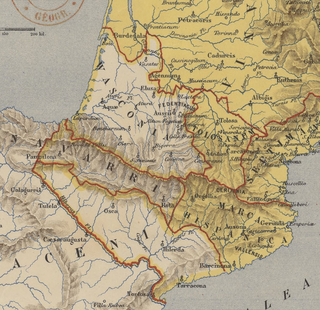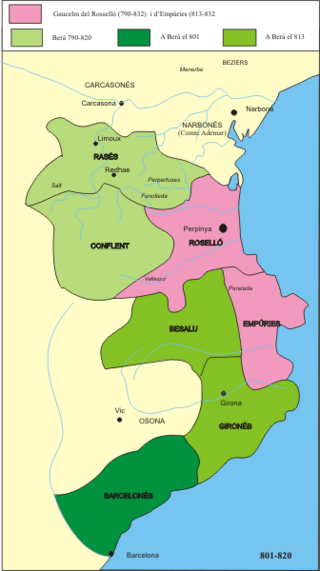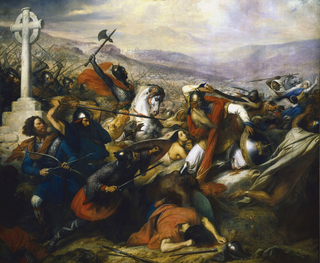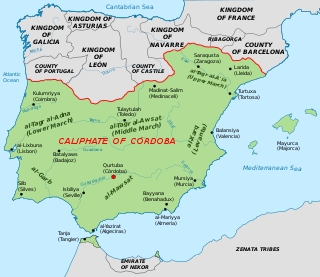
Septimania is a historical region in modern-day Southern France. It referred to the western part of the Roman province of Gallia Narbonensis that passed to the control of the Visigoths in 462, when Septimania was ceded to their king, Theodoric II. During the Early Middle Ages, the region was variously known as Gallia Narbonensis, Gallia, or Narbonensis. The territory of Septimania roughly corresponds with the modern French former administrative region of Languedoc-Roussillon that merged into the new administrative region of Occitanie. In the Visigothic Kingdom, which became centred on Toledo by the end of the reign of Leovigild, Septimania was both an administrative province of the central royal government and an ecclesiastical province whose metropolitan was the Archbishop of Narbonne. Originally, the Goths may have maintained their hold on the Albigeois, but if so it was conquered by the time of Chilperic I. There is archaeological evidence that some enclaves of Visigothic population remained in Frankish Gaul, near the Septimanian border, after 507.

The Battle of Roncevaux Pass in 778 saw a large force of Basques ambush a part of Charlemagne's army in Roncevaux Pass, a high mountain pass in the Pyrenees on the present border between France and Spain, after his invasion of the Iberian Peninsula.

The Spanish March or Hispanic March, was a military buffer zone beyond the former province of Septimania, established by Charlemagne in 795 as a defensive barrier between the Umayyad Moors of Al-Andalus and the Frankish Carolingian Empire.
The history of Toulouse, in Midi-Pyrénées, southern France, traces back to ancient times. After Roman rule, the city was ruled by the Visigoths and Merovingian and Carolingian Franks. Capital of the County of Toulouse during the Middle Ages, today it is the capital of the Midi-Pyrénées region.
Gaucelm was a Frankish count and leading magnate in Gothia during the reign of Louis the Pious. He was initially the Count of Roussillon from about 800, but he received Empúries in 817 and was thenceforward the chief representative of imperial authority in that region.

Bera was the first count of Barcelona from 801 until his deposition in 820. He was also the count of Razès and Conflent from 790, and the count of Girona and Besalú from 812 until his deposition. In 811, he was witness to the last will and testament of Charlemagne.
Rampon (Rampó) was the second count of the Catalan counties of Barcelona and Osona from 820 until his death in 825.
Sa'dun al-Ruayni was Governor, or Wali, of Barcelona from 792 to 801 and the penultimate Muslim ruler of the city.

The County of Barcelona was originally a frontier region under the rule of the Carolingian dynasty. In the 10th century, the Counts of Barcelona became progressively independent, hereditary rulers in constant warfare with the Islamic Caliphate of Córdoba and its successor states. The counts, through marriage, alliances and treaties, acquired the other Catalan counties and extended their influence over Occitania. In 1164, the County of Barcelona entered a personal union with the Kingdom of Aragon. Thenceforward, the history of the county is subsumed within that of the Crown of Aragon, but the city of Barcelona remained preeminent within it.
The siege of Narbonne was fought in 737 between the Arab and Berber Muslim forces of Yusuf ibn Abd al-Rahman al-Fihri, Arab Umayyad Muslim governor of Septimania on behalf of al-Andalus, and the Frankish Christian army led by the Carolingian king Charles Martel.

The Catalan counties were the administrative Christian divisions of the eastern Carolingian Hispanic Marches and the southernmost part of the March of Gothia in the Pyrenees created after their rapid conquest by the Franks.
Septimania was the western region of the Roman province of Gallia Narbonensis that passed under the control of the Visigoths in 462. It passed briefly to the Emirate of Córdoba in the eighth century before its reconquest by the Franks, who by the end of the ninth century termed it Gothia. This article presents a timeline of its history.
The County of Pallars or Pallás was a de facto independent petty state, nominally within the Carolingian Empire and then West Francia during the ninth and tenth centuries, perhaps one of the Catalan counties, originally part of the Marca Hispanica in the ninth century. It was coterminous with the upper Noguera Pallaresa valley from the crest of the Pyrenees to the village of Tremp, comprising the Vall d'Àneu, Vall de Cardós, Vall Ferrera, the right bank of the Noguera Ribagorçana, and the valley of the Flamicell. It roughly corresponded with the historic region of Catalonia called Pallars. Its chief city was Sort.

There was an Abbasid–Carolingian alliance during the 8th and 9th centuries, effected through a series of embassies, rapprochements and combined military operations between the Frankish Carolingian Empire and the Abbasid Caliphate.

The Umayyad invasion of Gaul occurred in two phases in 719 and 732 AD. Although the Umayyads secured control of Septimania, their incursions beyond this into the Loire and Rhône valleys failed. By 759 they had lost Septimania to the Christian Franks, but would return in the 10th century to establish Fraxinetum based in Provence.
Wilfred or Wifred, called the Hairy, was Count of Urgell, Cerdanya, Barcelona, Girona, Besalú and Ausona. On his death in 897, his son, Wilfred Borrell, inherited these Catalan counties.

The siege of Narbonne took place in France between 752 and 759, led by the Frankish king Pepin the Short against the Umayyad stronghold defended by an Andalusian garrison of Arab and Berber Muslim troops, who had invaded Septimania and occupied the Gothic settlement with its Gallo-Roman inhabitants since 719. The siege remained as a key battlefield in the context of the Carolingian expedition south to Provence and Septimania starting in 752.

The Battle of Pancorbo was a battle that took place in the year 816 between a Moorish army from the Emirate of Cordoba sent by Al-Hakam I and under the control of Abd al-Karim ibn Abd al-Wahid ibn Mugit and the pro-Frankish forces under the control of Balask al-Yalasqi. The battle was fought when the Córdoban forces attempted to cross the pass at Pancorbo.

The Upper March was an administrative and military division in northeast Al-Andalus, roughly corresponding to the Ebro valley and adjacent Mediterranean coast, from the 8th century to the early 11th century. It was established as a frontier province, or march, of the Emirate, later Caliphate of Córdoba, facing the Christian lands of the Carolingian Empire's Marca Hispanica, the Asturo-Leonese marches of Castile and Álava, and the nascent autonomous Pyrenean principalities. In 1018, the decline of the central Cordoban state allowed the lords of the Upper March to establish in its place the Taifa of Zaragoza.
A Jewish Princedom in Feudal France, 768–900 is a book about Frankish medieval history by Arthur J. Zuckerman.










